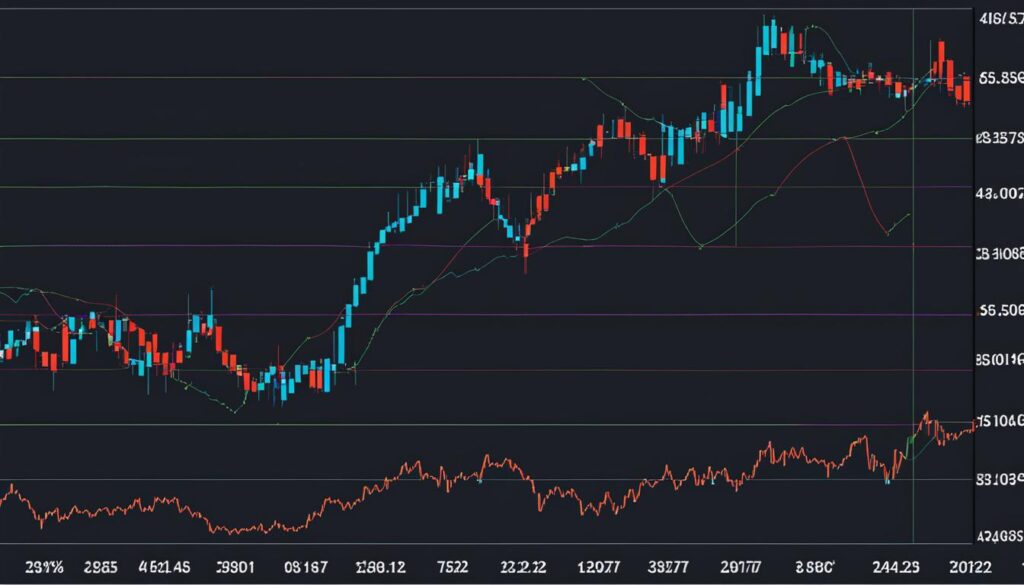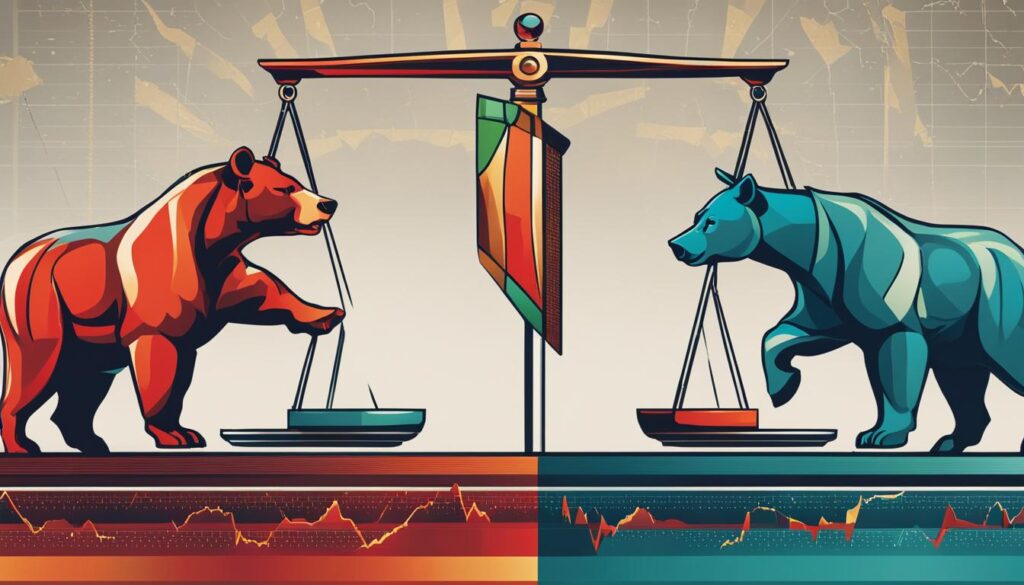As an experienced options trader, I understand the challenges of navigating volatile markets. That’s why I want to introduce you to the risk reversal strategy, an advanced options approach that can help protect and hedge your stock positions in unpredictable market conditions.
The risk reversal strategy is a versatile tool that allows you to adapt to changing market dynamics. It involves buying a put option and selling a call option or buying a put spread option and selling a call spread option. By doing so, you can change the risk profile of your position from bullish to bearish or vice versa.
Risk reversals are widely used by large institutions to hedge their long stock positions. They are known for their flexibility and effectiveness in managing risk. Whether you’re a seasoned trader or just starting out, understanding and implementing risk reversals can enhance your options trading strategy.
Key Takeaways:
- The risk reversal strategy is an advanced approach to options trading in volatile markets.
- It involves buying a put option and selling a call option or buying a put spread option and selling a call spread option.
- Risk reversals can change the risk profile of a position from bullish to bearish or vice versa.
- They are commonly used by large institutions to hedge their long stock positions.
- Implementing risk reversals requires a deep understanding of options trading and market dynamics.
Understanding Risk Reversals
A risk reversal is a strategy that involves the use of call and put options or call spread and put spread options. The goal of a risk reversal is to protect a long stock position from adverse market moves by offsetting potential losses with the sale of call options. This strategy is commonly used by institutions to temporarily get short delta without impacting their portfolio of stocks.
Implementing a risk reversal involves buying or selling call and put options. When buying a call option, the trader has the right to buy the underlying stock at a specified price within a designated time frame. Conversely, when buying a put option, the trader has the right to sell the underlying stock at a specified price within a designated time frame. On the other hand, when selling these options, the trader takes on the obligation to buy or sell the underlying stock if assigned.
By combining these options, risk reversals provide a way to protect against potential losses in a long stock position. The seller of call options generates income and, in return, assumes the risk of upside potential. The risk reversal options strategy can be illustrated using risk graphs, which visually depict the potential profitability and risk of a position in different market scenarios.
Understanding Risk Graphs and Their Impact
Risk graphs are an essential tool for understanding the potential outcomes of a risk reversal strategy. These graphs display the profit or loss that can be achieved at different stock prices and time periods. They can help traders visualize how changes in stock price, option expiration, and volatility may impact their positions.
“Risk graphs are an invaluable resource for traders as they provide a clear visual representation of the potential risk and reward of a position. By using risk graphs, traders can make informed decisions regarding their risk reversals and adjust their strategies accordingly.”
Here is an example of a risk graph for a risk reversal strategy:
| Stock Price | Profit/Loss |
|---|---|
| $50 | $10 |
| $60 | $5 |
| $70 | -$3 |
| $80 | -$12 |
This risk graph illustrates the potential profit or loss at different stock prices. Traders can use it to assess the risk and reward of their risk reversal options strategy and make informed decisions accordingly.
Understanding risk reversals and risk graphs is crucial for traders looking to protect their long stock positions and manage risk effectively. By leveraging these strategies and tools, traders can navigate volatile markets with confidence.
Using Single Options and Option Spreads for Risk Reversals
Risk reversals provide traders with the flexibility to create positions using either single options or option spreads. Each approach offers its own set of advantages and considerations.
Single Options
When using single options for risk reversals, traders have the ability to quickly enter and exit positions, thanks to the liquidity of individual options contracts. This allows for faster fills and potentially lower transaction costs. Additionally, single options generally require lower margin requirements compared to option spreads.
Selling or buying single options can offer strategic advantages, but it’s important to be aware of the associated risks. If the underlying asset moves against the position, there is the potential for substantial losses.
Option Spreads
Option spreads, on the other hand, can provide certain advantages over single options when constructing risk reversals. By utilizing spreads, traders can reduce margin requirements and limit potential losses. Option spreads offer a certain level of protection, but it’s important to note that they may not offer as much potential profit as single options in certain scenarios.
In summary, here are the advantages and considerations of using single options and option spreads for risk reversals:
| Advantages | Considerations |
|---|---|
|
|
Understanding the advantages and considerations of using single options and option spreads is crucial for constructing effective risk reversals. Traders should carefully evaluate their risk tolerance, market conditions, and investment goals when deciding between these two approaches.
Directional Risk Reversals
Risk reversals provide options traders with the flexibility to implement bullish or bearish directional trades. A bearish risk reversal strategy involves buying a put spread and simultaneously selling a call spread. On the other hand, a bullish risk reversal entails selling a put spread while buying a call spread.
The primary objective of a directional risk reversal is to profit from a market move in the desired direction while also minimizing risks. This strategy allows traders to leverage the “house money” and potentially increase their profits.
“The directional risk reversal strategy offers an opportunity for options traders to align their positions with their market outlook, aiming to capitalize on favorable price movements. By using put and call spreads, traders can precisely define their risk and reward profiles.”
Directional risk reversals can be particularly useful in volatile markets where price fluctuations create opportunities for substantial gains. Traders can implement bearish or bullish risk reversals based on their assessment of market trends and potential risks.
Risk Reversal Examples
To illustrate the concept of directional risk reversals, consider the following examples:
-
Bearish Risk Reversal:
Option Premium Buy Put Spread 1.50 Sell Call Spread 0.50 In this scenario, the trader buys a put spread for $1.50 and simultaneously sells a call spread for $0.50. By doing so, the trader is positioned to profit from a downward market move.
-
Bullish Risk Reversal:
Option Premium Sell Put Spread 0.80 Buy Call Spread 0.30 In this example, the trader sells a put spread for $0.80 and buys a call spread for $0.30. This strategy allows the trader to profit from an upward market move.
By implementing directional risk reversals, options traders can align their positions with market expectations and potentially capitalize on favorable price movements.

Adjustments and Exiting Risk Reversals
Risk reversals, as highly flexible options strategies, can be adjusted to align with changing market conditions and investor opinions. Traders can employ various techniques to modify risk reversals based on their desired risk and reward profiles. One common adjustment is to convert one side of the risk reversal into a broken wing butterfly, reshaping the risk graph and potentially enhancing the strategy’s profit potential.
Additionally, risk reversals can be exited or adjusted to hedge against upside risk. By closing out part or all of the position, traders can lock in profits and manage risk effectively. Exiting a risk reversal can be influenced by changes in market sentiment or the achievement of desired profit targets.
Flexibility is a key advantage of risk reversals, allowing traders to adapt to market dynamics and adjust their positions accordingly. Regular monitoring of the strategy is essential to identify opportunities for adjustments, whether it involves modifying strike prices, expiration dates, or the overall position.
“The ability to adjust and exit risk reversals provides traders with the flexibility to navigate volatile markets and manage risk effectively.”
As in any trading strategy, risk reversals require careful consideration of market conditions, volatility levels, and individual risk tolerance. Traders should evaluate their positions regularly and make adjustments as needed to optimize the risk-reward ratio.

Risk Reversal Adjustments
| Adjustment Technique | Description |
|---|---|
| Convert to a Broken Wing Butterfly | By modifying one side of the risk reversal, traders can transform their position into a broken wing butterfly, allowing for greater profit potential. |
| Close or Adjust the Position | Risk reversals can be closed partially or entirely to lock in profits or hedge against upside risk. Adjustments may involve modifying strike prices or expiration dates. |
Conclusion
Risk reversals are a valuable tool for advanced options traders looking to manage risk in volatile markets. They offer several advantages, including low cost, flexibility, and the ability to adjust according to market conditions. By using risk reversals, traders can effectively hedge their positions and protect themselves against adverse market moves.
However, it’s important to be aware of the potential drawbacks of risk reversals. The high margin requirements and the risk of large losses should not be overlooked. Traders must thoroughly understand the nuances of risk reversals and be prepared to actively manage and adjust their positions to mitigate these risks.
In conclusion, risk reversals provide a strategic approach to managing risk in the dynamic world of options trading. By mastering this technique and employing it judiciously, traders can navigate volatile markets with greater confidence and potentially enhance their profitability.
FAQ
What is the risk reversal strategy?
The risk reversal strategy is a versatile tool that can be used to protect or hedge a stock, position, or portfolio in volatile markets. It involves buying a put option and selling a call option or buying a put spread option and selling a call spread option. This strategy can change the risk of a position from bullish to bearish or vice versa.
How do risk reversals work?
A risk reversal is a strategy that involves the use of call and put options or call spread and put spread options. The goal of a risk reversal is to protect a long stock position from adverse market moves by offsetting potential losses with the sale of call options. This strategy is commonly used by institutions to temporarily get short delta without impacting their portfolio of stocks.
What are the advantages of using risk reversals?
Risk reversals have advantages such as low cost, low risk, and flexible adjustment options. They allow traders to protect against adverse market moves and manage risk effectively.
How can risk reversals be adjusted to match changing market conditions?
Risk reversals are highly flexible and can be adjusted to match changing market conditions and investor opinions. One common adjustment is to convert one side of the risk reversal into a broken wing butterfly. Risk reversals can also be closed or adjusted to hedge off some of the upside risk.
When should I exit a risk reversal?
Knowing when to exit a risk reversal is crucial and can be based on changes in market opinion or the achievement of desired profits. It is important to monitor the position and make adjustments as needed to manage risk effectively.
Are there any risks associated with risk reversals?
Yes, there are risks associated with risk reversals. They include high margin requirements and the potential for large losses if the underlying asset moves against the position.



